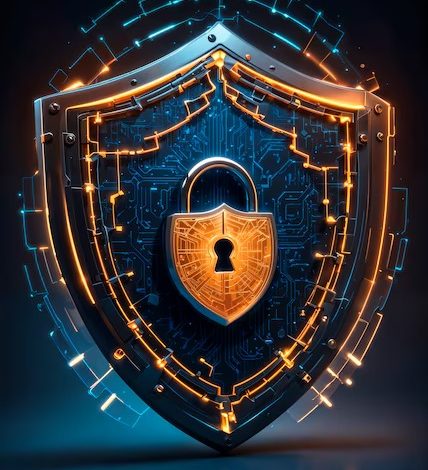
Information Security With Blockchain
Information Security With Blockchain, Blockchain technology has become a significant frontier in the field of information security, providing novel answers to enduring problems. Blockchain technology, which was first intended to serve as the foundation for cryptocurrencies like Bitcoin, has developed beyond its financial origins to become a disruptive force in a number of areas, including cybersecurity, Visit info tech to learn more.

Understanding Blockchain Technology
Fundamentally, blockchain is a distributed, decentralized ledger that securely and openly records transactions via a network of computers. The manner that data is organized—into blocks that are connected to one another to form a chain—is where the term “blockchain” originates. The data’s integrity and immutability are guaranteed by this structure.
Key features of blockchain technology include
- Decentralization: Unlike traditional centralized systems, blockchain operates on a peer-to-peer network, distributing control and authority across all participants. This decentralization reduces the risk of a single point of failure or malicious manipulation.
- Immutability: Once information is added to a block and the block is added to the chain, it becomes extremely difficult to alter. Each block contains a cryptographic hash of the previous block, creating a secure and tamper-resistant chain of data.
- Transparency: The entire transaction history is visible to all participants in the network. This transparency enhances trust among users and provides a clear audit trail.
- Consensus Mechanisms: Blockchain networks rely on consensus mechanisms to validate and agree on the state of the ledger. Common consensus mechanisms include Proof of Work (PoW) and Proof of Stake (PoS), ensuring that transactions are legitimate before being added to the blockchain.
Blockchain in Information Security
- Enhanced Data Integrity: Blockchain’s immutability ensures the integrity of data. Once information is recorded on the blockchain, it cannot be altered retroactively without changing subsequent blocks. This feature is particularly valuable in scenarios where data integrity is paramount, such as financial transactions, legal contracts, and medical records.
- Secure Identity Management: Blockchain has the potential to revolutionize identity management by providing a secure and decentralized way to manage digital identities. Users can have control over their identity information, and the distributed nature of blockchain reduces the risk of identity theft and unauthorized access.
- Decentralized Authentication: Traditional centralized authentication systems are susceptible to single points of failure and large-scale data breaches. Blockchain enables decentralized authentication, where cryptographic keys and smart contracts authenticate users without the need for a central authority. This can significantly reduce the risk of unauthorized access.
- Smart Contracts for Automated Security: Smart contracts, self-executing contracts with the terms of the agreement directly written into code, are a powerful application of blockchain technology. In the context of information security, smart contracts can automate security processes, such as access control, threat detection, and incident response. This automation enhances efficiency and reduces the risk of human error.
- Supply Chain Security: Blockchain enhances the security of supply chains by providing a transparent and traceable ledger of transactions. From the source to the end user, stakeholders in a supply chain can use blockchain to verify the authenticity of products, track shipments, and ensure the integrity of the entire supply chain ecosystem.
- Immutable Audit Trails: The transparency and immutability of blockchain make it an ideal technology for creating auditable trails. In sectors like healthcare, finance, and legal, where maintaining a secure and verifiable record of transactions is critical, blockchain can serve as an immutable audit trail.
- Securing Internet of Things (IoT) Devices: With the proliferation of IoT devices, security concerns have risen. Blockchain can provide a decentralized and secure framework for authenticating and managing IoT devices. This ensures that only authorized devices can interact with each other, reducing the risk of unauthorized access or tampering.
- Protection Against Data Tampering: In traditional databases, a malicious actor with access to a centralized system can alter or delete data. Blockchain’s distributed and decentralized nature makes it resistant to tampering. Once information is added to the blockchain, any attempt to alter it would require consensus from the majority of the network, making it highly secure against unauthorized changes.
- Tokenization for Access Control: Tokenization involves converting sensitive information into a unique token that has no exploitable value. Blockchain can be used for tokenization, enhancing access control mechanisms. Instead of storing sensitive information directly, systems can store tokens on the blockchain, reducing the risk associated with centralized storage.
- Decentralized Threat Intelligence Sharing: Blockchain facilitates the secure sharing of threat intelligence among organizations without compromising sensitive information. The decentralized and transparent nature of the blockchain allows entities to share information about emerging threats, helping the global cybersecurity community stay ahead of evolving risks.
Challenges and Considerations
While blockchain offers significant benefits for information security, there are challenges and considerations:
- Scalability: Some blockchain networks face scalability issues, limiting their ability to process a large number of transactions quickly. Efforts are underway to address scalability concerns through innovations like sharding and layer 2 solutions.
- Regulatory Uncertainty: The regulatory landscape for blockchain and cryptocurrencies is still evolving. Uncertainty around legal frameworks and compliance may impact the widespread adoption of blockchain in certain industries.
- Energy Consumption: Proof of Work (PoW) consensus mechanisms, learn about more blockchain used by some blockchains like Bitcoin, require significant computational power and energy consumption. Transitioning to more energy-efficient consensus mechanisms, such as Proof of Stake (PoS), is a consideration for sustainability.
- Interoperability: Achieving interoperability between different blockchain networks and legacy systems is a challenge. Standardization efforts and the development of cross-chain solutions aim to address this issue.
- User Education: Understanding blockchain technology and its implications for information security requires a certain level of technical literacy. User education and awareness are essential for the successful implementation of blockchain solutions.
Discover more from Infotech
Subscribe to get the latest posts sent to your email.





